Can I Feed a Savannah Monitor Baby Food to Get It to Eat Again Its Been Half Starved
The Savannah Monitor is 1 of the smallest and nearly pop species among the monitor genus.
They are pop because they are very friendly and are easier to keep than other larger monitors.
This does non hateful they are suitable for beginners and they all the same require advanced care.
Known to similar insects and small mammals, they are an inactive pet and will spend most of their time basking or lounging in their enclosure.
These African lizards need to live in large enclosures with loftier temperatures. If you are interested, read i below to discover out how to intendance for them…

Table of Contents
- Savannah Monitor Overview
- What We Like About Savannah Monitors
- Species Appearance
- How Big Will a Savannah Monitor Get?
- Color Variations and Markings
- Savannah Monitor Enclosure
- Savannah Monitor Cage & Set Up
- Cleaning & Misting
- Savannah Monitor Intendance
- Savannah Monitor Nutrition
- Savannah Monitor Lifespan & Health
- Typical Behavior
- Are Savannah Monitors Friendly?
- Handling Advice and Tips
- Baby Savannah Monitor
- Buyer's Guide
- Savannah Monitor Facts
- Summary
Savannah Monitor Overview
Savannah Monitors are naturally found in sub-Saharan Africa. As their name implies (savannah terrain), they like to alive among the rocky desert and woodlands.
This species is used to the hot temperatures of sub-Saharan Africa. They naturally soak themselves in pools of water to keep absurd.
Reptile owners beloved them because they accept a very docile nature when compared with larger monitor species.
Grayish-tan in appearance, they have spots on their backs and rings on their short tails.
They eat a variety of invertebrates and small mice. In the wild, they hunt using their tongue to pick up chemic cues from the surround they live in.
Solitary lizards, they will simply interact with their own species during the breeding flavor. If you are planning to keep this reptile, it should exist the only one you have in the enclosure.
Unfortunately, they are considered to exist endangered past some organizations due to hunters seeking them out for their skin.
What We Like About Savannah Monitors
Pros
- One of the friendlier monitor species, they make a neat first monitor.
- Relatively few health issues and are very hardy.
- Tin can survive in low humidity and take low husbandry requirements.
- They can grow up to three feet in length and weigh as much every bit 11 pounds. Grayish-tan in color, they take dorsal spots and rings on their tail.
Cons
- This species must exist housed alone. You cannot accept more than than one in an enclosure at once.
- They need a very big enclosure and their housing set-up may be costly.
- Savannah Monitors are carnivorous; eating insects every bit well every bit the occasional rodent.
- They require extremely loftier temperatures in their basking spot.
Species Appearance
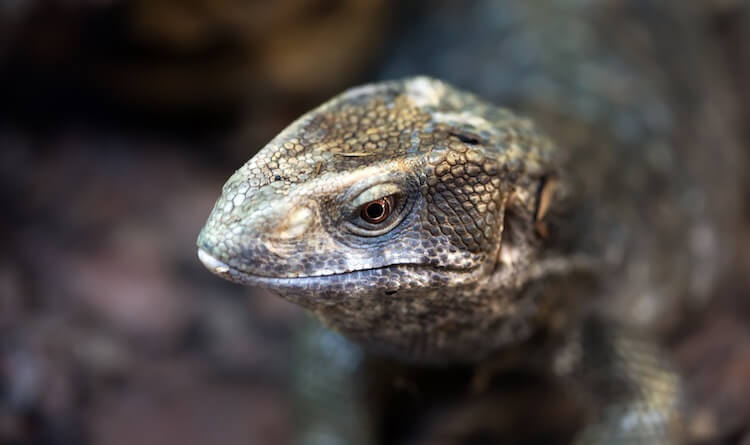
There are five subspecies of the Varanus exanthematicus, so their appearance and size volition vary based on which species y'all purchase.
However, all Monitors accept deeply forked tongues. This helps them choice upward chemical signals from their surround.
Their typical appearance is stocky and thick with a wide head.
They accept a short neck and tail.
You may demand to rely on a veterinarian or expert herpetologist to sex your lizard, because there is no truthful sexual dimorphism. This makes it very difficult to tell males and females apart.
How Big Will a Savannah Monitor Get?
Full grown Savannah Monitor lizards are between two to four feet in length by four years onetime. They can weigh as much equally 13 pounds.
At nascency, Babies are only a couple inches long, but they grow incredibly quickly.
Color Variations and Markings
This species has a gray-brownish base of operations color with have night-edged yellow spots on their back. They have a blueish natural language and yellow and brownish rings on their tail.
Savannah Monitor Enclosure
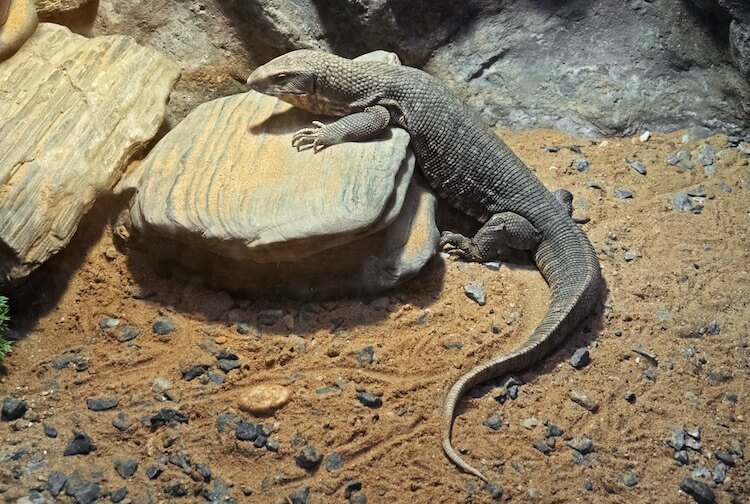
This lizard lives in a natural habitat of rocky deserts and forests in Africa's wild savannah.
They are relatively inactive in the wild. They volition spend much of their time basking and soaking themselves and will probable display similar behaviors in their enclosures.
Because they similar to spend plenty of fourth dimension soaking and in the woods, their cage should take some logs, branches, rocks, and even cork bark slabs.
Any of these items will work as long every bit they can be easily cleaned or removed for cleaning.
Savannah Monitor Cage & Prepare
Although they are only considered a medium-sized monitor Savannahs are still a large reptile.
They need a large enclosure which should accept a space of about 5ft x 4ft x 4ft – if non more.
Their tank will likely need to be custom made and should be ready for when yous bring your lizard home.
Enclosures should exist made of plexiglass or plastic.
The summit of their enclosure should take a screen to let for airflow, whilst being secured to forestall any escapes. These monitors are very strong and smart.
Baby Savannah Monitors should be kept in 50-gallon tanks. This tank volition be big plenty for their commencement six months.
They abound chop-chop and so some reptile owners determine to put them directly into their adult enclosures:
- Tank Blazon: plastic or plexiglas muzzle.
- Tank Size: 5ft x 4ft x 4ft minimum.
- Lighting: UVB and high wattage basking bulb required.
- Substrate: newspaper.
Agile during the day, they crave a UVB calorie-free for essential vitamin product, particularly for babies! Lighting should be on for virtually 12 hours of calorie-free and 12 hours of darkness each day. You lot should besides utilise an incandescent bulb to create a very hot basking spot. Make sure the incandescent light is out of reach from your monitor.
In terms of temperature, the daytime gradient in the enclosure should be 80℉-95℉.
A basking spot should be even warmer, as high every bit 120℉ is ideal.
Existence a desert-type lizard, Savannah Monitors are not as picky nigh their humidity levels as many other reptiles.
In their natural environs, it is very dry and arid. Because of this, the basking spot tin be kept at very low humidity. The rest of the tank should be kept at between a 50 to 60% humidity.
The water-pool in your Savannah Monitor's enclosure should be big enough to soak in besides.
Finally, because monitors are messy, a suitable substrate would be something that tin be cleaned easily! It will need to be spot cleaned every day and thoroughly cleaned out at least once a week.
Given that they will be in a large enclosure a substrate like paper will exist the easiest to clean. Make certain non to apply sand or gravel every bit this tin cause bowel obstruction, especially in Juveniles.
You should also avoid reptile carpet equally it can entangle and tear their large claws.
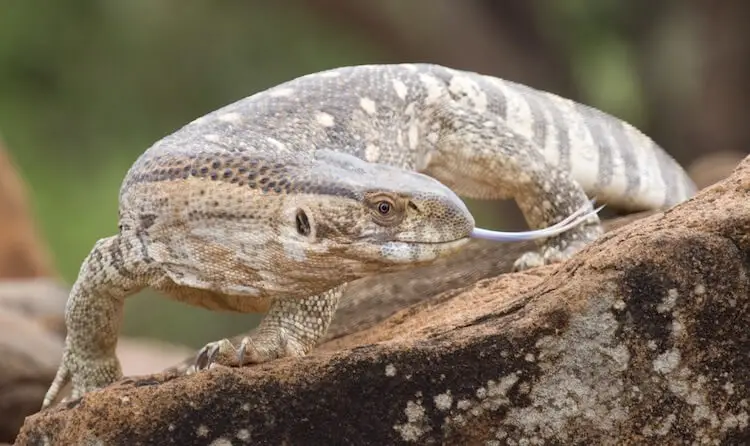
Cleaning & Misting
As a species, monitors are very messy and defecate frequently. They have a tendency to defecate in their h2o, then exist sure to monitor it advisedly and immediately alter it if it becomes dirty.
Their puddle of water should contribute to keeping the tank at mid-level humidity, and y'all should non have to mist the tank. The all-time fashion to continue rail of this is to place a humidity gauge on the cool side of the tank and but mist if the humidity falls below 40%.
Their enclosures must be cleaned ofttimes.
Feces should have a normal solid brown part and a solid white office likewise. If information technology is unusually colored or textured, this may exist a sign of a health trouble.
Feces should be spot cleaned every day from their enclosure, peculiarly if information technology is in their water.
The entire tank should be thoroughly cleaned out every week or two.
This may require removing substrate or diverse logs and branches and temporarily homing your monitor somewhere else.
Savannah Monitor Care
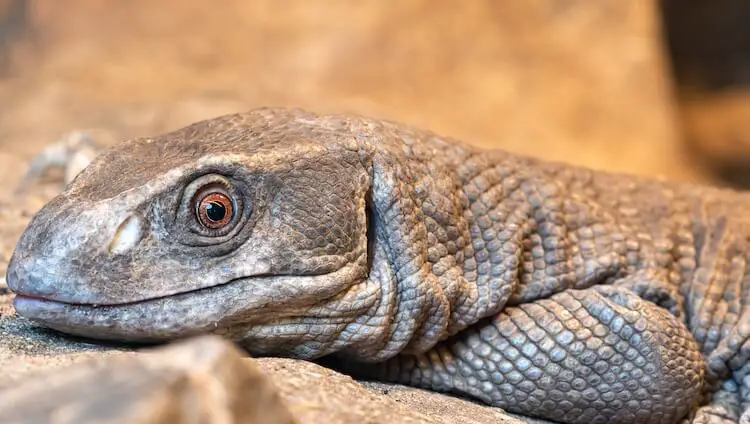
Savannah Monitor Diet
This Lizard eats a variety of invertebrates and pocket-size mammals in the wild. They are not picky about what they consume and may eat insects, mealworms, pocket-size mice, or even snails. You can on occasion feed a mouse. They may likewise swallow thoroughly cooked pieces of beefiness, simply ideally they should stick to mice and invertebrates.
A carnivorous reptile, they hunt and sense their environs by flicking their tongue to pick up chemic cues.
Nutrient should be dusted with a calcium supplement, and a multivitamin should exist fed if yous are not feeding mice to your monitor.
When y'all feed your monitor, identify the food into the cage so that they tin can provender for it. This keeps them more active:
- Adults should exist fed several insects 1-2 times a week (larger monitors may eat less oft).
- Juveniles should be fed ii-3 times per week.
- Babies should be fed every other twenty-four hour period.
Baby Savannah Monitors will eat the same basic diet, anything from crickets and waxworm larva to pre-weaning mice.
Any live food, for adults or babies, should be removed at the end of the day if uneaten.
Finally, monitors should ever accept admission to make clean water.
Their h2o bowl should be big enough for them to soak in; born containers or plastic pans piece of work great.
Savannah Monitor Lifespan & Health
Savannah Monitors live near 12 years in captivity but can live upward to twenty years with good husbandry.
They usually have few health bug in captivity, specially if they are captive-bred.
2 distinct problems may occur with a poor diet:
- Metabolic os disease can result from a lack of calcium and may crusade your lizard to feel sluggish.
- Obesity can result from overfeeding your monitor. If your Lizard starts abnormally gaining weight, you may need to restrict the amount of food they are consuming temporarily.
Wild-caught Monitors are prone to having parasites, which is one reason that you should acquire this species through a breeder.
They enjoy soaking themselves, so y'all shouldn't need to bathe them.
Signs They Are Healthy
- Basking and soaking unremarkably.
- Eager to eat.
- Articulate and bright eyes.
Sickness Symptoms
- Lethargic and sluggish.
- Sudden weight gain.
- Dragging their limbs or tail.
Typical Beliefs
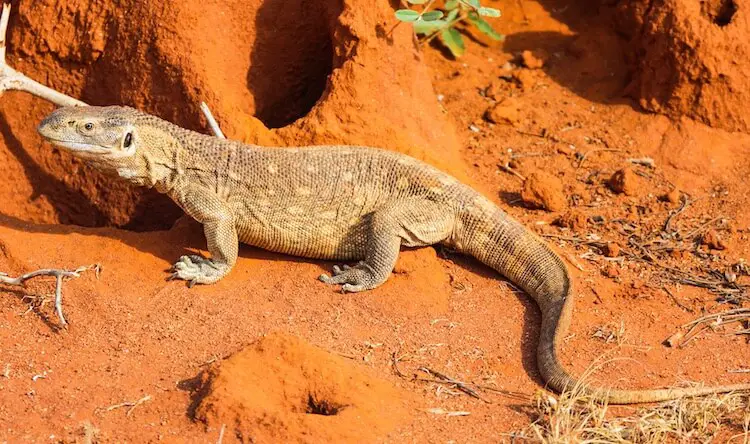
When non in captivity, the Savannah Monitor is a alone reptile and volition only socialize with its own species during its breeding season.
Known for beingness very territorial, males will fight if they come into contact with one another.
They are not peculiarly active creatures and will spend time lounging in or out of the basking spot.
Near of their fourth dimension will exist spent basking and occasionally foraging for nutrient, they do this with tongue flicking. Tongue flicking in captivity may indicate that your monitor is hungry or just existence curious.
They but communicate with each other through pheromones and other chemical signals which they detect with their tongue.
Mating and fighting will show different forms of communication.
To ward off predators, they might hiss loudly and thrash their tail, or information technology may play expressionless equally a final resort.
These creatures must exist housed alone due to their territorial behavior towards other lizards.
Are Savannah Monitors Friendly?
Yes, especially every bit far as monitors get. They are a very friendly species and can be taught to tolerate handling over a flow of time.
They are more often than not one of the less nervous monitor species so get along well with their owners.
All the same, they are strong lizards and require a strong grip.
Once tame they may not bear witness assailment to you lot.
A wild adult can deliver a strong bite or nasty scratch it not socialized properly.
Handling Advice and Tips
The Savannah Monitor is one of the almost docile species among the monitor genus. However, this does not mean they tame easily.
Monitors require a lot of patience and work from their keeper to to be well-socialized.
Safe handling requires lots of confront time and repetitive treatment.
Information technology is a commonly known fact that most reptiles bear Salmonella bacteria. Washing your easily before and subsequently handling is good for your health and can prevent infections.
Some other problem owners may find during handling are scratches from their lizard'south nails.
The all-time manner to handle your monitor is to place a firm grip behind the reptile's head and put one paw near the hind limbs.
Baby Savannah Monitor
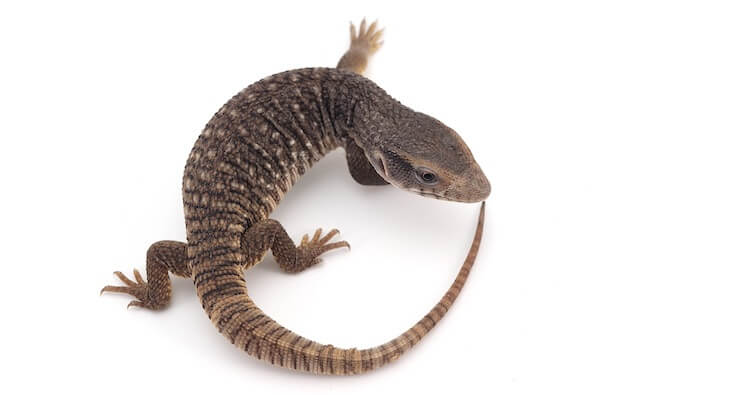
The breeding flavor occurs during the wet season (i.e. May). A male will follow a female and will periodically bite and scratch her neck until she allows copulation.
Females need a nest box to lay eggs. In the wild, she would usually make her ain or lay them in a termite mound. For your monitor, a suitable nest box can be a plastic tub filled with soil.
Later she lays her eggs, they should exist incubated in groups in a ten-gallon aquarium filled with vermiculite and h2o.
At that place is a 5-half-dozen month incubation fourth dimension, and the container should be opened occasionally to allow oxygen in. They should be incubated at 82℉, and the temperature and moisture should be monitored advisedly.
There are usually twenty-50 eggs per clutch.
Hatchlings are a couple inches long at nascence.
They will start eating insects and other invertebrates a week afterward hatching. They will need to be feed nearly every 24-hour interval at the starting time and then less often as they age (run into diet guide above).
Buyer's Guide
Savannah Monitors are 1 of the more than readily bachelor monitors and cost about $l to $100 USD.
It is strongly recommended that you obtain your Lizard from a trusted breeder, rather than somewhere where they are wild-caught.
Wild-defenseless monitors are highly decumbent to having parasites and are ofttimes stressed when forced to adapt to a convict lifestyle. Breeding them in captivity tin can be difficult, so while finding a captive-bred monitor may prove to exist more of a claiming, it is worth the endeavor for your experience and the species' protection.
Savannah Monitor Facts
| Vital Facts | |
|---|---|
| Mutual Proper name | Savannah Monitor |
| Scientific Proper name | Varanus exanthematicus |
| Price | ~$100 |
| Size | two.5 to four feet long |
| Lifespan | 12 to xx years |
| Diet | Insects and other invertebrates |
| Tank Size | Minimum 5ft x 4ft ten iv ft |
| Humidity & Temperature | Daytime temperature: fourscore℉-95℉ Basking Spot: 100°F-120°F Humidity: 60% |
| Popular Alternatives | Ackies Monitor, Black or White Throated Monitors |
Summary
Savannah Monitors are one of the more than docile monitors in the world of reptile keeping.
They practice require a high temperature in a large habitat, just they also have an like shooting fish in a barrel feeding routine and are tame.
If y'all are looking for a smaller breed of Monitor, the Ackies is a very popular choice and is easier for some beginners to handle. If you lot are looking for more than of a challenge, the Black or White-Throated Monitor is a practiced thought.
They can make a great and fascinating addition to a home, volition information technology exist for you?
Source: https://www.everythingreptiles.com/savannah-monitor/

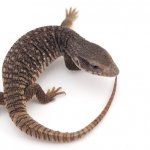



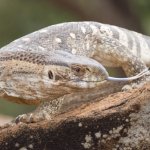
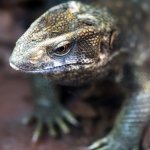
0 Response to "Can I Feed a Savannah Monitor Baby Food to Get It to Eat Again Its Been Half Starved"
إرسال تعليق